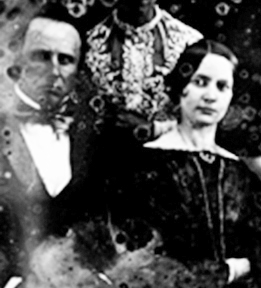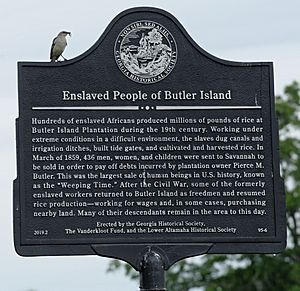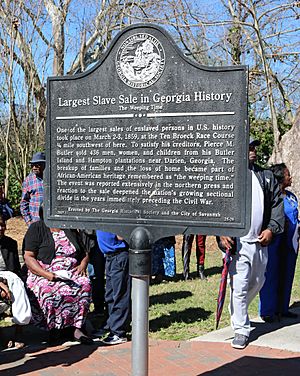Great Slave Auction facts for kids

The Great Slave Auction, also known as the Weeping Time, was a huge sale of enslaved African people. It took place at the Ten Broeck Race Course near Savannah, Georgia, United States, on March 2 and 3, 1859. Slaveholder Pierce Mease Butler owned many plantations but did not live on them. He decided to sell about 436 men, women, children, and babies over two days. The money from this sale was used to pay off Butler's large debts, much of which came from gambling. This auction was the biggest single sale of enslaved people in U.S. history.
Contents
Who Was Pierce Mease Butler?
The Butler family, from South Carolina and Philadelphia, owned large plantations where enslaved people worked. These plantations were on Butler Island and St. Simons Island, just south of Darien, Georgia. The family's wealth came from hundreds of enslaved people who grew rice and cotton. Major Pierce Butler, the family's leader, was one of the richest and most powerful slave owners in the United States. When he died, he left his wealth to his two grandsons, Pierce Mease Butler and John A. Mease Butler.
Pierce Mease Butler was not good with money. He often made risky business choices, which led to financial losses, especially during the Panic of 1857. He also spent a lot of money. His large gambling debts caused him the most trouble. To pay off these debts, the management of Butler's property was given to trustees. First, they sold Butler's mansion in Philadelphia for $30,000. They sold other property too, but it wasn't enough to pay everyone Butler owed money to. The only valuable things left were the enslaved people on his Georgia plantations.
The Auction Day

Savannah was a good place for the auction because it was close to the Butler plantations and was a major center for the slave trade. Pierce Butler had the upcoming sale advertised in The Savannah Republican and The Savannah Daily Morning News. Joseph Bryan, a slave dealer in Savannah, handled the advertisements. They ran daily, except Sundays, until the last day of the sale. Some ads said: "For Sale, Long Cotton and Rice Negros! A gang of 440, Accustomed to the culture of Rice and Provisions, among them are a no of good mechanics and house servants, will be sold on 2nd and 3rd day of March at Savannah by J Bryan." The advertisements promised that families would not be separated.
The enslaved people were brought to the race track four days before the auction. This allowed buyers to inspect them. On the first day of the sale, about 200 buyers were there. Heavy rains kept many potential buyers away, and the auction started two hours late. During the sale, Joseph Bryan was in charge of feeding the enslaved people and keeping them in "good" condition. They were kept in horse barn stalls. All family members were put into the same stall. They had nothing but the hard wooden floors to sit and eat on. They were given small amounts of rice, beans, and sometimes cornbread over the two days. The enslaved people were skilled in many crafts, like shoemaking, barrel making (cooperage), blacksmithing, and carpentry. Some had even learned to use machines. Skilled enslaved people sold for more money and were highly sought after by buyers.
Enslaved People at the Sale

The enslaved people arrived in Savannah by steamboat and train. They were housed in the stables at the racecourse, huddled together, eating and sleeping on the floor. From February 26 to March 1, buyers inspected them. Eager customers from Virginia, North and South Carolina, Georgia, Alabama, and Louisiana came to Savannah hoping to get good deals. It was known that the Butler plantations had enslaved people who were skilled in shoemaking, cooperage, blacksmithing, carpentry, and machine operation. Buyers would poke, pinch, and touch the enslaved people, even opening their mouths to check their teeth. They were also checked for any injuries or problems that might affect their ability to work.
Four hundred and thirty-six people were listed in the sale catalog, but only 429 were sold. Those not sold were either sick or disabled. Most of those sold were field workers for rice and cotton. Others were skilled barrel makers, carpenters, shoemakers, blacksmiths, and cooks. The two-day sale brought in $303,850. The highest price paid for a family, a mother and her five grown children, was $6,180. Prices for one person ranged from $250 to $1,750.
What Happened After
Mortimer Thomson, a popular journalist at the time, wrote about the event. He went to Savannah and pretended to be interested in buying enslaved people to gather information. After the sale, he wrote a long and powerful article for the New York Tribune called "What Became of the Slaves on a Georgia Plantation."
After the enslaved people were freed by the Emancipation Proclamation and the defeat of the Confederate States, some returned to Butler Island. They worked for wages, and some bought land in the area.
Historical Markers
Two historical markers in Georgia highlight this event. One is at 2053 Augusta Avenue in Savannah, Georgia. It was put up by the city and the Georgia Historical Society in 2008. The other is at Butler Plantation, put up by the Georgia Historical Society in 2019.

